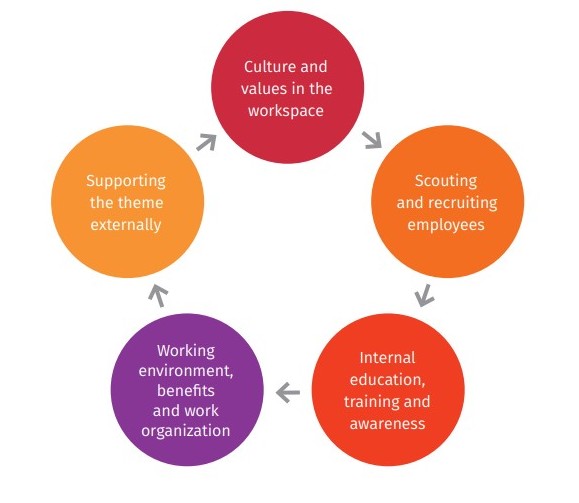About diversity
DIVERSITY, INCLUSION AND THE FEELING THAT WE BELONG TO WORKPLACE
Diversity is any dimension by which we can distinguish between groups of people and individuals. It is a conscious acceptance of the fact that we as people are diversified in terms of age, gender, ethnicity, religion, disability, sexual orientation, education or nationality. The differences between us are either visible or invisible. In recent years, aspects of invisible diversity have also come to the fore in an active approach to diversity and inclusion at workplace. These include, for example, introvertedness/extrovertedness, cognitive diversity (diverse thinking), different work and life experiences or tendency to anxiety or susceptibility to mental health problems.

Inclusion means creating a safe and respectful environment that accepts people as they are. Mutual understanding and tolerance are prerequisites for social and cultural acceptance and equal treatment. The result of a successful inclusive approach is the sense of belonging. It is not just a quiet tolerance of otherness, but also a sense of active support that allows people to perform at their best. The inclusion process involves each individual and makes people feel as an important part of the company or organisation. Such cultural shift constitutes companies and organisations with higher performance level thanks to motivated employees.
“Diversity means having a place at the table, inclusion means having a voice, and ̒belonging̕ means that this voice will be heard.”
Liz Fosslien and Mollie West Duffy
Diversity management is based on the uniqueness of every individual and purposefully creates strategies, policies and programs that create a respectful environment. Companies and organisations applying diversity management in practice go beyond compliance with the antidiscrimination legislation. They value and recognise their diverse employees as well as perceive and develop their potential. In this way, they contribute to the better functioning of the organisation as a whole and achieve better results.

DISCRIMINATION AND ITS FORMS
Observance of the principle of equal treatment consists of the protection against discrimination, adoption of measures to prevent discrimination, equal treatment of employees as well as ensuring equal opportunities. The principle of equal treatment does not mean that the employer shall treat all employees equally in every situation. On the contrary, it assumes that in justified cases the employer will consider the special requirements and needs of a particular employee (e.g. adapt the workplace to health condition of a specific employee).
Direct discrimination is a conduct when an individual is treated less favourably than others are in a similar situation. Discrimination may manifest itself in direct actions or omissions when an individual is treated, has been treated or could have been treated less favourably compared to someone else in a comparable situation.
Example:
“The employer excluded you from the recruiting process because your permanent or temporary address is in a locality primarily inhabited by socially excluded groups of population.”
Example:
“The employer has given you a written warning for breaching work discipline due to the increased time spent at a hygienic break during your period.”
Indirect discrimination is an apparently neutral provision, decision, instruction or practice, which puts or could put a person at disadvantage compared to another person when applied in practice.
Example:
“The employer has decided to condition certain benefits also by an extra work performed by employees beyond their labour contracts, thus, disadvantaging those employees that cannot work overtime or undertake extra tasks due to their health or family situation.”
Harassment as a form of discrimination creates or may create an intimidating, hostile, shameful, humiliating, degrading, disrespectful or offensive environment, whose aim or consequence is or may be an interference into personal liberty or human dignity of a victim. At workplace, harassment can manifest itself also as bullying, but not every form of harassment can be considered bullying. A one-time activity that does not last long does not fulfil the elements of bullying. If bullying occurs because of the personal characteristics of an employee (e.g. his or her sexual orientation or ethnic origin), such actions can be defined as discrimination in the form of harassment.
Example:
“Your superior addresses you with a disgraceful nickname because of your religion.”
Sexual harassment is a form of harassment of a sexual nature. It may manifest itself verbally, non-verbally or physically as a conduct of a sexual nature whose intention or consequence can or may be a violation of a person´s dignity and which creates an intimidating, degrading, disrespectful, hostile or offensive environment for a victim. Sexual harassment, especially in its verbal form, is often justified as an innocent flirtation or an expression of affection. However, the fact that sexual harassment represents an unwanted and undesirable behavioural pattern by the victim, serves as a distinguishing feature. At the same time, a conduct bearing the characteristics of sexual harassment may lead to the perpetration of the criminal offences of rape, sexual violence or dangerous stalking.
Example:
“Your superior conditions his or her approval of your vacation by a sexual intercourse with you.”
BENEFITS OF PROMOTING DIVERSITY AND NON-DISCRIMINATION AT WORKPLACE FOR EMPLOYERS
- Sound reputation of the employer
- Motivation and productivity of employees
- Recruiting talented people
- Promotion of innovation
- Better access to customers and clients, higher profits
- Reduction of fluctuation
- Cost prevention
WHERE AND HOW TO INTEGRATE TOPICS OF DIVERSITY AND INCLUSION AT WORKPLACE?
Everyday functioning of workplace is based on fundamental values. The values of inclusion and respect should be integrated in the core internal documents of every company or organisation, e. g. in the Code of Ethics. These documents define the overall culture in the company and the expected behaviour of employees. Non-discriminatory and inclusive approach should be already notable during the recruitment process. The way a job offer is written, what the requirements for a given position are, who is present in the selection committee – these all have a significant impact on whether a person, who, based on unconscious prejudices, might not even be our first choice at all is hired.
Ignorance leads to misunderstandings and prejudices. The most effective way to tackle them is talking about them. Therefore, continuous internal education, trainings and awareness raising at workplace are of a key importance. The working environment, benefits and organisation of work should reflect the needs of diverse employees. Just as accessibility affects whether a person in a wheelchair can be employed, so does the possibility of occasional work from home help working parents solve an unexpected situation. The values of respect and tolerance should not only relate to your workplace. By advocating the topic externally, you will give an example and a specific inspiration to other employers and send an important signal to the society.

PREVENTING AND RESOLVING CASES OF DISCRIMINATION AT WORKPLACE
Employment relationships are one of the areas in which discrimination in the abovementioned forms is prohibited. The employer is obliged to prevent discrimination, resolve it in case it occurs and support victims of discrimination. Employees are obliged to refrain from discrimination of other employees. The employer shall respect the prohibition of discrimination and ensure equal treatment with employees and potential employees in all stages of an employment relationship.
The obligation to refrain from discrimination is laid upon the employer directly by law. A breach of this obligation can lead to legal consequences (e.g. litigation, sanction from a labour inspectorate).
By setting up an effective system for handling discrimination complaints at your workplace, you can prevent litigation and provide the employees concerned with a prompt and effective solution to the situation. If the employee feels discriminated against, he or she can complain directly to the national equality body (Slovak National Centre for Human Rights) or resolve the situation through the courts (either on his or her own or through a lawyer). The choice of any of these options does not mean that subsequently the use of another option is not possible or that the person concerned cannot decide to opt for several options at the same time.
If an employer sets up an effective mechanism for handling complaints alleging discrimination and intolerance at workplace and efficiently applies it into practice, the employer gains trust of employees that their situation would be resolved and can avoid lengthy litigation associated with the risk of reputation or loss and fluctuation of employees.
Learn more about diversity and non-discrimination: